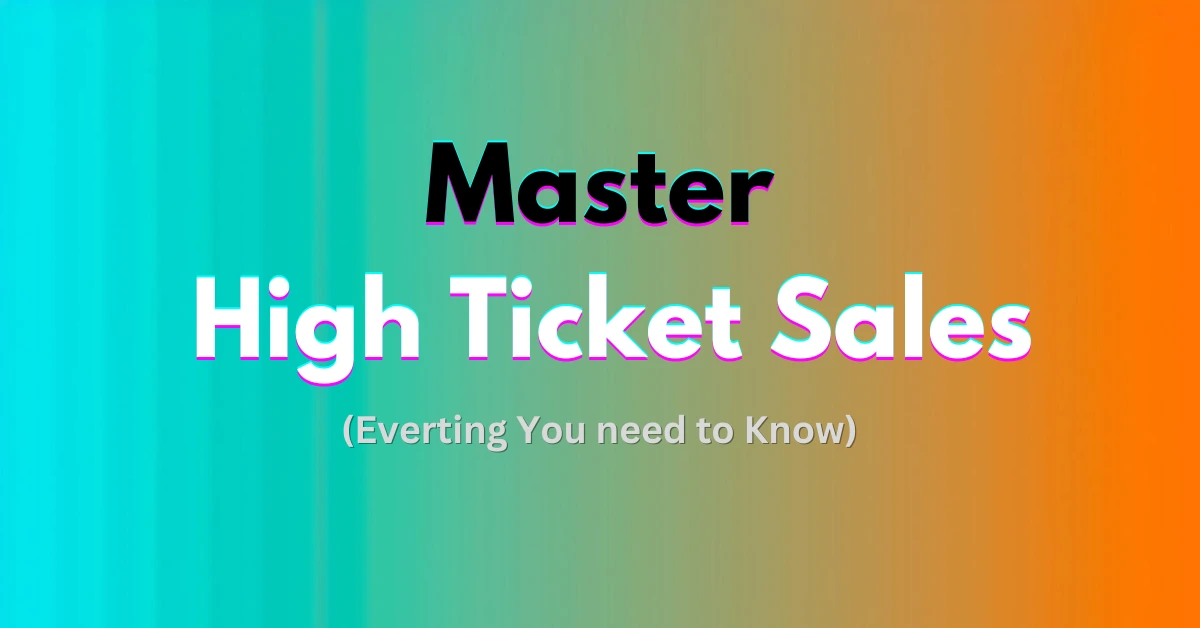GTM Meaning | Go-to-Market Strategy, Definition, & Key Benefits
In today’s competitive business environment, many companies struggle to launch their products efficiently into the market. Without a well-defined GTM (Go-to-Market) strategy, businesses often face challenges like misaligned sales and marketing efforts, missed opportunities, and slower growth. The confusion around the GTM meaning and how a proper go-to-market plan should be executed can also lead to wasted resources, confusion in target audiences, and ultimately, unsuccessful product launches.
The solution lies in developing a clear and effective GTM strategy, which outlines a structured approach to bringing a product to market. By having a roadmap for understanding target markets, sales tactics, and marketing strategies, businesses can streamline their operations, increase sales, and ensure that their products resonate with the right audience at the right time. A solid GTM strategy helps organizations achieve market success, improve product adoption, and drive revenue growth.
The Essentials of a Go-to-Market Strategy
What is a Go-to-Market Strategy?

GTM meaning? A Go-to-Market (GTM) strategy is a comprehensive plan that businesses use to introduce a product or service to the market. It involves defining the target market, identifying key customer segments, and crafting the most effective methods to reach them. At its core, a GTM strategy helps companies determine how to position their product in the market, communicate its value proposition, and generate sales.
In essence, the GTM strategy bridges the gap between product development and the actual market launch. It encompasses everything from market research and competitive analysis to sales tactics and marketing campaigns, ensuring that every aspect of the launch is well-coordinated and aligned with business goals. Whether you’re a tech company launching a SaaS product or a retailer introducing a new line of products, a well-executed GTM strategy is key to ensuring the success of your product in the marketplace.
Understanding terms like PMB (Project Management Baseline) can help businesses keep their GTM plans on track by ensuring clear, measurable goals and project timelines are established.
Why is GTM Important?
A Go-to-Market strategy is essential for businesses aiming for growth, especially when introducing a new product or entering a new market. Without a clear GTM strategy, businesses may find themselves wasting valuable resources and time, failing to connect with the right customers, or experiencing product delays. It ensures that all departments, from sales to marketing, work in harmony, enhancing efficiency and reducing the risk of failure.
A strong GTM strategy also helps companies establish a competitive edge by clearly defining how their product or service meets customer needs in a way that is different from the competition. It allows for more accurate forecasting, better resource allocation, and ultimately, a greater chance of achieving market success. By aligning marketing, sales, and customer service with the right strategy, businesses can increase product adoption rates, accelerate revenue growth, and strengthen their position in the market.
Similar to how a radiator regulates a car’s temperature to keep it running smoothly, a GTM strategy regulates how a business aligns its efforts to ensure a successful product launch.
Key Elements of a Go-to-Market Strategy
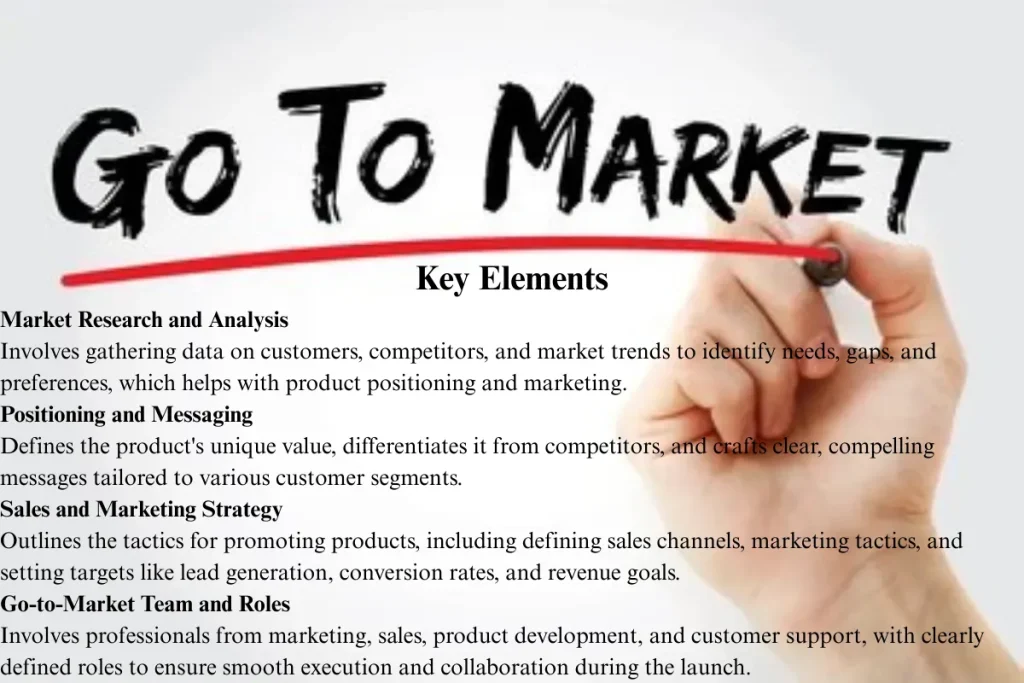
Market Research and Analysis
Market research is one of the most crucial components of any Go-to-Market (GTM) strategy. It involves gathering and analyzing data about potential customers, competitors, and the overall market landscape. By conducting thorough research, businesses can identify customer needs, market gaps, and trends that can help shape the direction of their product launch.
Effective market research ensures that a company understands its target audience’s preferences, pain points, and behavior. It also helps in segmenting the market based on demographics, geographic locations, and psychographic factors. This data is vital for making informed decisions about product positioning and ensuring that marketing messages resonate with the right audience. Without proper research, businesses risk misinterpreting customer needs, which could lead to poor product adoption and missed sales opportunities.
Positioning and Messaging
Positioning and messaging are vital components of a GTM strategy as they define how a product will be perceived in the market. Product positioning involves identifying the unique value that the product provides to its target audience and differentiating it from competitors. It answers the question, “Why should customers choose your product over others?”
Once positioning is established, messaging plays a key role in communicating this value effectively to the target market. It focuses on crafting clear, compelling, and consistent messages that highlight the product’s benefits, features, and advantages. Messaging should be tailored to various customer segments and delivered across the right channels to maximize impact. Strong positioning and messaging help create a lasting impression on customers, driving product awareness, interest, and ultimately, conversions.
Sales and Marketing Strategy
The sales and marketing strategy within a GTM plan outlines the tactics that will be used to promote the product and convert leads into paying customers. This element is focused on how to reach customers, engage them, and ultimately drive sales. It involves defining the right sales channels (online, direct, resellers, etc.) and deciding on the most effective marketing tactics (content marketing, social media, email campaigns, etc.).
A well-crafted sales and marketing strategy ensures that all efforts are aligned and integrated, creating a seamless experience for customers. It also sets clear targets, such as lead generation goals, conversion rates, and revenue milestones. By using a targeted sales and marketing approach, businesses can effectively generate demand, build brand awareness, and drive product sales in a competitive market.
Go-to-Market Team and Roles
The Go-to-Market team plays a pivotal role in executing the strategy. It includes professionals from various departments, such as marketing, sales, product development, and customer support. Each team member contributes to the overall success of the GTM plan by handling specific aspects of the launch, from campaign creation to customer outreach.
Having a clearly defined GTM team with well-outlined roles ensures that there is no overlap or confusion during the product launch. For example, the marketing team will focus on creating awareness and generating leads, while the sales team will work on closing deals and nurturing customer relationships. The product team ensures that the product aligns with customer needs, and customer service addresses any inquiries or issues post-launch. Collaboration and communication among team members are essential for ensuring the smooth execution of the GTM strategy.
By having the right team in place, companies can move quickly and effectively when launching new products, ensuring they meet market demand while staying ahead of the competition.
Frameworks and Models for GTM Strategy
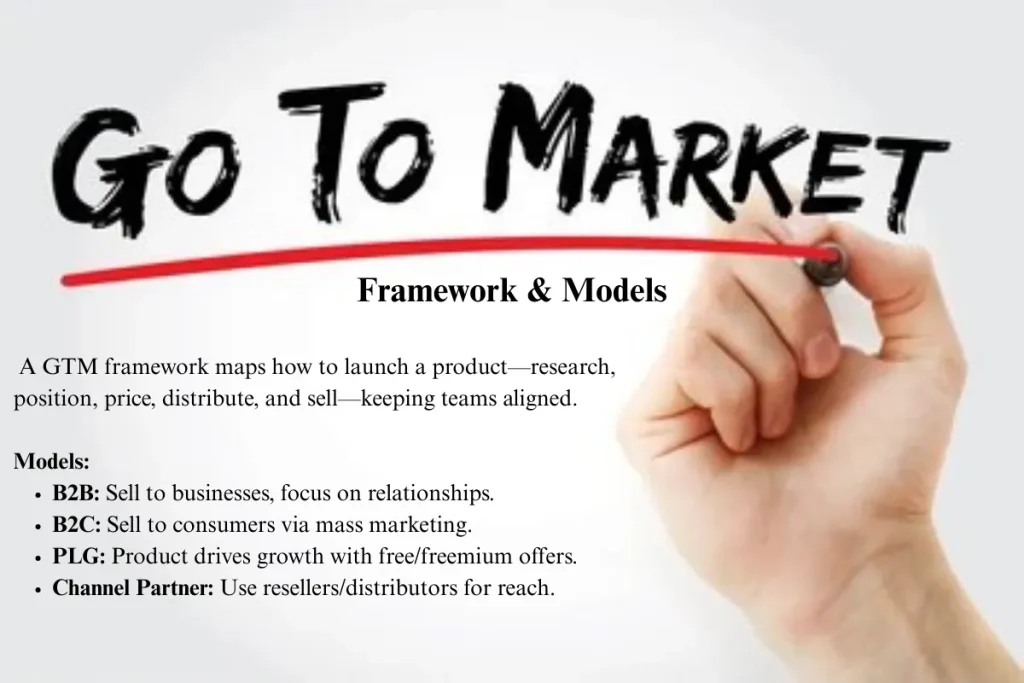
GTM Framework
A Go-to-Market (GTM) framework provides businesses with a structured approach to developing their GTM strategy. It is a systematic guide that helps companies map out the key components and stages of launching a product in the market. While each business and product is unique, a GTM framework provides a foundation that can be adapted to different industries and needs.
Key elements in a typical GTM framework include market research, segmentation, positioning, pricing, distribution, and sales strategies. A good framework outlines how these elements work together to drive success in the market. For example, it will detail how to conduct research to define your target audience and how to position your product to address customer pain points effectively. It also emphasizes creating a timeline for execution and defining measurable objectives to track progress.
Utilizing a GTM framework helps businesses stay organized and focused, reducing the risk of overlooking important aspects of the product launch. It also ensures that all teams are aligned and working towards the same goals, leading to a more efficient and successful market entry.
Go-to-Market Models
There are several Go-to-Market models businesses can adopt, depending on their product type, target market, and resources. Each model has its strengths and challenges, and choosing the right one can significantly impact the success of a product launch.
- B2B (Business-to-Business) GTM Model
- In a B2B GTM strategy, businesses sell their products or services to other businesses. This model often involves longer sales cycles, relationship-building, and highly personalized selling. A successful B2B GTM strategy focuses on establishing strong partnerships, providing tailored solutions, and delivering value through customer support.
- Example: A software company offering enterprise solutions would use a B2B model to target large businesses and decision-makers.
- In a B2B GTM strategy, businesses sell their products or services to other businesses. This model often involves longer sales cycles, relationship-building, and highly personalized selling. A successful B2B GTM strategy focuses on establishing strong partnerships, providing tailored solutions, and delivering value through customer support.
- B2C (Business-to-Consumer) GTM Model
- In a B2C GTM strategy, businesses target individual consumers. This model typically requires mass marketing techniques, such as advertising, promotions, and online sales channels. The goal is to build brand awareness and drive direct sales through various consumer touchpoints.
- Example: A fashion brand using social media advertising and influencer marketing to sell directly to consumers would adopt a B2C GTM strategy.
- In a B2C GTM strategy, businesses target individual consumers. This model typically requires mass marketing techniques, such as advertising, promotions, and online sales channels. The goal is to build brand awareness and drive direct sales through various consumer touchpoints.
- PLG (Product-Led Growth) Model
- A Product-Led Growth (PLG) strategy revolves around using the product itself to drive customer acquisition, retention, and expansion. This model is typically used by SaaS (Software as a Service) companies, where the product is the primary driver of growth. The product is designed to be user-friendly, offering a free trial or freemium version to attract users who then convert to paying customers over time.
- Example: A project management tool offering a free version of its software that encourages users to upgrade as they see value in its features.
- A Product-Led Growth (PLG) strategy revolves around using the product itself to drive customer acquisition, retention, and expansion. This model is typically used by SaaS (Software as a Service) companies, where the product is the primary driver of growth. The product is designed to be user-friendly, offering a free trial or freemium version to attract users who then convert to paying customers over time.
- Channel Partner Model
- The Channel Partner Model involves partnering with third-party distributors, resellers, or affiliates to help bring a product to market. This model is often used by companies looking to expand into new regions or industries without establishing a direct sales force.
- Example: A tech company partnering with electronics retailers to sell their products in stores across multiple countries.
- The Channel Partner Model involves partnering with third-party distributors, resellers, or affiliates to help bring a product to market. This model is often used by companies looking to expand into new regions or industries without establishing a direct sales force.
By choosing the right Go-to-Market model, businesses can tailor their approach to their target market and product type, ensuring a more efficient and effective product launch. The key is to identify the most suitable model that aligns with the company’s goals and resources.
Go-to-Market Strategy Examples
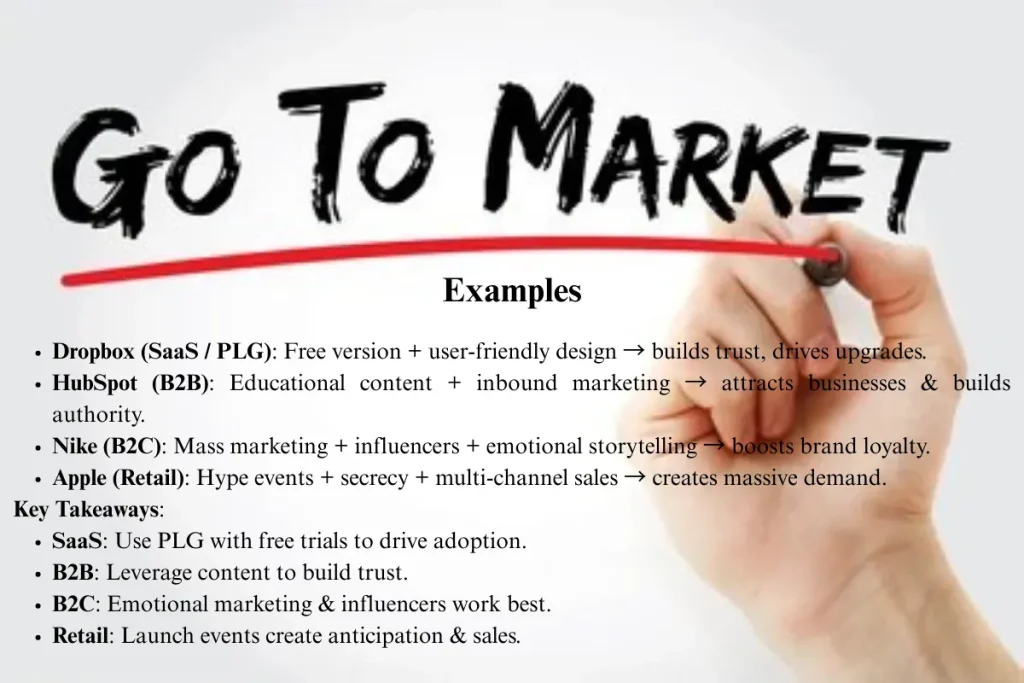
Case Studies of GTM in Action
Real-world examples of Go-to-Market (GTM) strategies offer valuable insights into how different companies successfully launch products in competitive markets. Let’s explore a few examples across various industries to understand how businesses have applied their GTM strategies to drive growth and achieve success.
- SaaS Product Launch – Dropbox
- Dropbox used a Product-Led Growth (PLG) model to launch its file storage service, emphasizing the product’s user-friendly interface and free trial. The company started by targeting small teams and individual users, offering a free version of its product with limited storage. This helped Dropbox quickly gain traction and expand its user base. As users saw the product’s value, they became more likely to upgrade to a paid version, driving the company’s growth.
- Key Takeaway: PLG is highly effective for SaaS products that offer value upfront. A free version or trial can build trust, lead to organic word-of-mouth referrals, and eventually convert users into paying customers.
- Dropbox used a Product-Led Growth (PLG) model to launch its file storage service, emphasizing the product’s user-friendly interface and free trial. The company started by targeting small teams and individual users, offering a free version of its product with limited storage. This helped Dropbox quickly gain traction and expand its user base. As users saw the product’s value, they became more likely to upgrade to a paid version, driving the company’s growth.
- B2B Model – HubSpot
- HubSpot, a marketing and sales software provider, adopted a B2B Go-to-Market model by offering a comprehensive inbound marketing platform to businesses. HubSpot’s GTM strategy focused on providing valuable content, such as blogs, eBooks, and webinars, to educate potential customers. The company used its product to demonstrate the power of inbound marketing, successfully attracting businesses looking to grow their online presence.
- Key Takeaway: Content marketing and thought leadership play a crucial role in B2B GTM strategies. By offering value through educational content, businesses can build trust with potential clients and establish themselves as experts in their field.
- HubSpot, a marketing and sales software provider, adopted a B2B Go-to-Market model by offering a comprehensive inbound marketing platform to businesses. HubSpot’s GTM strategy focused on providing valuable content, such as blogs, eBooks, and webinars, to educate potential customers. The company used its product to demonstrate the power of inbound marketing, successfully attracting businesses looking to grow their online presence.
- Consumer Product Launch – Nike
- Nike, a global leader in athletic apparel, uses a B2C Go-to-Market strategy that leverages mass marketing and influencer partnerships to promote its products. Nike’s GTM strategy includes partnerships with top athletes and celebrities, extensive advertising campaigns, and a strong social media presence. The brand’s marketing strategy focuses on emotional storytelling and positioning itself as more than just a product – it is a symbol of motivation and success.
- Key Takeaway: For B2C products, a strong brand identity and emotional marketing can help differentiate products in crowded markets. Collaborations with influential figures can also enhance the product’s appeal and reach.
- Nike, a global leader in athletic apparel, uses a B2C Go-to-Market strategy that leverages mass marketing and influencer partnerships to promote its products. Nike’s GTM strategy includes partnerships with top athletes and celebrities, extensive advertising campaigns, and a strong social media presence. The brand’s marketing strategy focuses on emotional storytelling and positioning itself as more than just a product – it is a symbol of motivation and success.
- Retail Product Launch – Apple
- When Apple launches new products, such as the iPhone, the company follows a meticulously planned GTM strategy. Apple’s approach combines retail, online sales, and media coverage, with the launch event itself acting as a major marketing moment. The company builds anticipation through secrecy and teaser campaigns, leading to massive demand at product launch.
- Key Takeaway: Event-based marketing and exclusive product launches can create anticipation and drive demand. Apple’s strategic use of media, influencers, and its retail stores strengthens its brand presence and ensures strong product sales.
- When Apple launches new products, such as the iPhone, the company follows a meticulously planned GTM strategy. Apple’s approach combines retail, online sales, and media coverage, with the launch event itself acting as a major marketing moment. The company builds anticipation through secrecy and teaser campaigns, leading to massive demand at product launch.
A strong self-empowerment mindset within the GTM team can help drive innovation and resilience during product launches. Empowering employees leads to better decision-making and quicker adaptation in a fast-paced market.
Key GTM Takeaways for Different Industries
Each industry has its own set of best practices for creating an effective GTM strategy, but the core principles remain the same: understanding the market, positioning the product effectively, and creating a cohesive sales and marketing plan.
- For SaaS products, a Product-Led Growth (PLG) approach with a freemium model or free trials can help build early adoption.
- For B2B companies, inbound marketing and building strong relationships through educational content are essential for attracting and retaining clients.
- For consumer-focused businesses, a B2C GTM strategy that combines mass marketing, influencer partnerships, and emotional storytelling can be effective in building brand awareness and driving sales.
By studying successful GTM strategy examples, businesses can adapt and apply proven tactics to their product launches, helping them navigate the complexities of the market and maximize their chances of success.
Developing a Go-to-Market Strategy
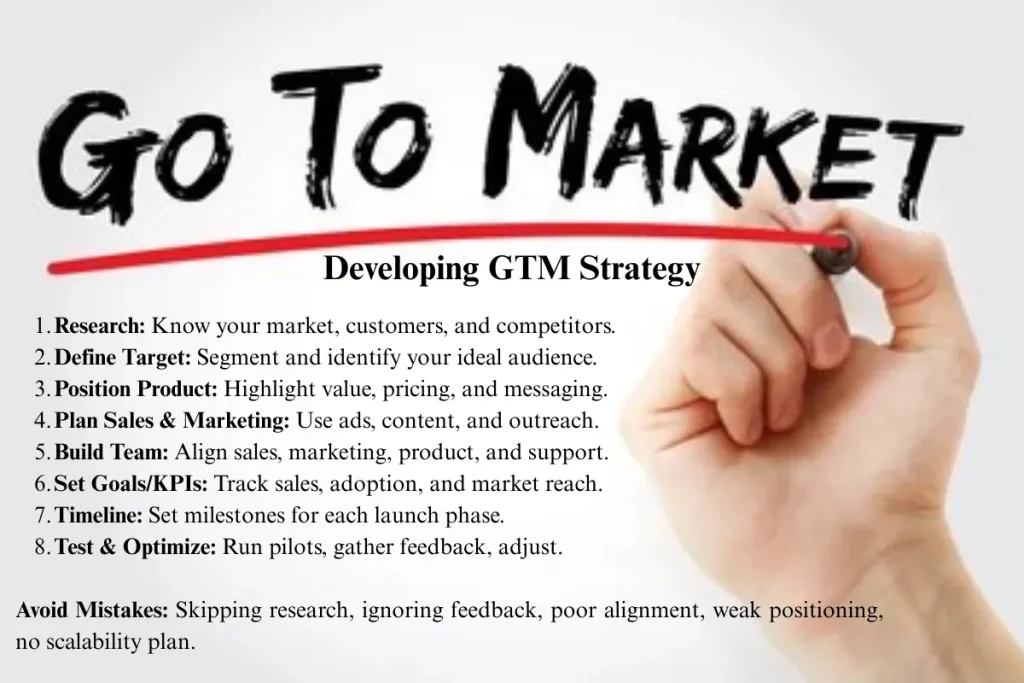
Steps to Build a GTM Strategy
Creating a Go-to-Market (GTM) strategy is a multi-step process that requires careful planning and execution. By following a structured approach, businesses can ensure they cover all the key areas and create a plan that drives success. Below are the essential steps to develop an effective GTM strategy:
- Conduct Market Research
- The first step in any GTM strategy is to gather relevant data. Understanding your target market, customer personas, and the competitive landscape is essential. Research should focus on identifying customer pain points, desires, and behaviors, as well as evaluating market trends and competitor strategies.
- The first step in any GTM strategy is to gather relevant data. Understanding your target market, customer personas, and the competitive landscape is essential. Research should focus on identifying customer pain points, desires, and behaviors, as well as evaluating market trends and competitor strategies.
- Define Your Target Market
- After research, businesses need to narrow down their target audience. This involves segmenting the market based on demographic, geographic, and psychographic data. Define who your ideal customer is and ensure that all marketing and sales efforts are tailored to meet their needs.
- After research, businesses need to narrow down their target audience. This involves segmenting the market based on demographic, geographic, and psychographic data. Define who your ideal customer is and ensure that all marketing and sales efforts are tailored to meet their needs.
- Position Your Product
- Product positioning defines how your product will be perceived in the market. Communicate your product’s value proposition – what makes it unique and why customers should choose it over competitors. This step also involves deciding on pricing, packaging, and overall messaging.
- Product positioning defines how your product will be perceived in the market. Communicate your product’s value proposition – what makes it unique and why customers should choose it over competitors. This step also involves deciding on pricing, packaging, and overall messaging.
- Create a Sales and Marketing Plan
- Once positioning is clear, develop a detailed sales and marketing plan. This plan should include tactics for reaching your target audience, such as digital marketing, influencer partnerships, paid ads, and content marketing. Additionally, outline the sales strategies that will be used, including sales team training, outreach methods, and sales funnels.
- Once positioning is clear, develop a detailed sales and marketing plan. This plan should include tactics for reaching your target audience, such as digital marketing, influencer partnerships, paid ads, and content marketing. Additionally, outline the sales strategies that will be used, including sales team training, outreach methods, and sales funnels.
- Build a Go-to-Market Team
- A successful GTM strategy requires collaboration across various departments. Establish a GTM team with representatives from sales, marketing, product, and customer service. Clearly define the roles and responsibilities of each team member to ensure smooth execution.
- A successful GTM strategy requires collaboration across various departments. Establish a GTM team with representatives from sales, marketing, product, and customer service. Clearly define the roles and responsibilities of each team member to ensure smooth execution.
- Set Goals and KPIs
- To measure the success of your GTM strategy, set specific, measurable goals and key performance indicators (KPIs). These may include sales targets, market penetration rates, customer acquisition costs, or product adoption metrics.
- To measure the success of your GTM strategy, set specific, measurable goals and key performance indicators (KPIs). These may include sales targets, market penetration rates, customer acquisition costs, or product adoption metrics.
- Develop an Execution Timeline
- A detailed timeline will help guide the execution of the strategy. This includes setting milestones for each phase of the product launch, from initial research and development to marketing campaigns and post-launch follow-ups. Having a clear timeline ensures that the launch stays on track and that all departments are aligned.
- A detailed timeline will help guide the execution of the strategy. This includes setting milestones for each phase of the product launch, from initial research and development to marketing campaigns and post-launch follow-ups. Having a clear timeline ensures that the launch stays on track and that all departments are aligned.
- Test and Optimize
- Before fully launching, it’s important to test the GTM strategy with a small segment of the target market. This could be a pilot program or a limited product release. Collect feedback, measure performance, and make necessary adjustments to improve the strategy before the full-scale launch.
Common Mistakes to Avoid
While developing a GTM strategy, there are several common mistakes that businesses should avoid to ensure a successful product launch:
- Neglecting Market Research
- Skipping thorough market research can lead to misguided decisions. Understanding customer needs and competitor strategies is crucial for creating a product that resonates with the target market.
- Skipping thorough market research can lead to misguided decisions. Understanding customer needs and competitor strategies is crucial for creating a product that resonates with the target market.
- Overlooking Customer Feedback
- It’s important to continuously gather customer feedback, especially during the initial phases of the launch. Ignoring feedback can result in missed opportunities for improvement.
- It’s important to continuously gather customer feedback, especially during the initial phases of the launch. Ignoring feedback can result in missed opportunities for improvement.
- Failing to Align Teams
- A GTM strategy requires cross-departmental alignment. If marketing, sales, and product teams aren’t on the same page, it can lead to confusion, inefficiency, and missed goals.
- A GTM strategy requires cross-departmental alignment. If marketing, sales, and product teams aren’t on the same page, it can lead to confusion, inefficiency, and missed goals.
- Underestimating the Importance of Positioning
- Proper product positioning is critical. Failing to communicate the product’s value proposition can make it difficult to differentiate from competitors and attract the right customers.
- Proper product positioning is critical. Failing to communicate the product’s value proposition can make it difficult to differentiate from competitors and attract the right customers.
- Not Planning for Scale
- It’s important to think beyond the initial product launch. Plan for growth and scalability from the outset, ensuring that resources, systems, and strategies can evolve as the product gains traction in the market.
By following these steps and avoiding common mistakes, businesses can create a Go-to-Market strategy that positions their product for success, ensuring effective market entry, high customer adoption, and long-term growth.
How to Create a Go-to-Market Strategy for Your Business
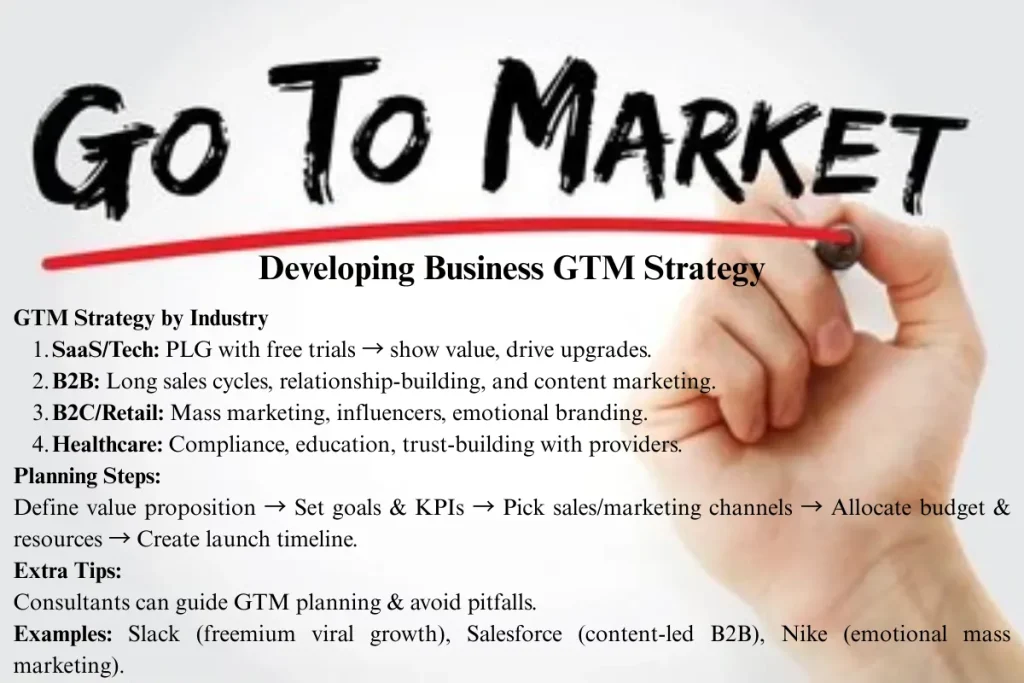
GTM Strategy for Different Industries
A Go-to-Market (GTM) strategy isn’t a one-size-fits-all solution – it must be tailored to suit the specific needs and challenges of your industry. Here, we’ll explore how GTM strategies vary across different sectors, providing you with industry-specific insights to create a winning plan.
- Tech and SaaS Industry
- For Software as a Service (SaaS) businesses, a PLG (Product-Led Growth) strategy is often the best approach. This strategy focuses on letting the product sell itself by offering a freemium model or free trial. The goal is to let users experience the product’s value before committing to a paid plan. SaaS companies need to emphasize ease of use, strong customer support, and clear onboarding processes.
- Key Considerations: Free trials, viral loops, and product features that drive customer engagement and retention. A strong customer support team and educational content are crucial for ensuring user success.
- For Software as a Service (SaaS) businesses, a PLG (Product-Led Growth) strategy is often the best approach. This strategy focuses on letting the product sell itself by offering a freemium model or free trial. The goal is to let users experience the product’s value before committing to a paid plan. SaaS companies need to emphasize ease of use, strong customer support, and clear onboarding processes.
- B2B Industry
- Business-to-Business (B2B) GTM strategies typically require longer sales cycles and more personalized approaches. The focus is often on relationship-building and offering tailored solutions to enterprise-level customers. Content marketing, webinars, and direct sales outreach are key elements in the B2B GTM strategy. In this context, inbound marketing (such as whitepapers, eBooks, and case studies) helps to nurture leads, while a strong sales team converts leads into paying customers.
- Key Considerations: Long-term relationship-building, in-depth product demos, and offering custom solutions that address the unique needs of business clients.
- Business-to-Business (B2B) GTM strategies typically require longer sales cycles and more personalized approaches. The focus is often on relationship-building and offering tailored solutions to enterprise-level customers. Content marketing, webinars, and direct sales outreach are key elements in the B2B GTM strategy. In this context, inbound marketing (such as whitepapers, eBooks, and case studies) helps to nurture leads, while a strong sales team converts leads into paying customers.
- Consumer Goods and Retail
- In the B2C (Business-to-Consumer) sector, the Go-to-Market strategy focuses on brand awareness, emotional connection, and mass marketing. Retail companies need a clear value proposition that differentiates them from competitors. Digital marketing, social media campaigns, influencer marketing, and even retail partnerships are all crucial components. Building strong customer loyalty through a combination of high-quality products and customer service is a priority.
- Key Considerations: Broad-reaching advertising (TV, digital, and print), influencer partnerships, and robust customer loyalty programs. Ensuring a seamless online and offline shopping experience is crucial.
- In the B2C (Business-to-Consumer) sector, the Go-to-Market strategy focuses on brand awareness, emotional connection, and mass marketing. Retail companies need a clear value proposition that differentiates them from competitors. Digital marketing, social media campaigns, influencer marketing, and even retail partnerships are all crucial components. Building strong customer loyalty through a combination of high-quality products and customer service is a priority.
- Healthcare and Medical Products
- The healthcare industry requires a highly regulated and specific Go-to-Market strategy. Marketing efforts should focus on patient education, compliance with regulations, and establishing trust. Sales cycles tend to be long, with a focus on building relationships with healthcare providers, hospitals, and medical practitioners. Digital marketing strategies should include informative content about the product’s medical benefits, along with case studies and patient testimonials.
- Key Considerations: Regulatory compliance, patient education, relationship-building with healthcare providers, and leveraging testimonials and clinical trials to build trust.
- The healthcare industry requires a highly regulated and specific Go-to-Market strategy. Marketing efforts should focus on patient education, compliance with regulations, and establishing trust. Sales cycles tend to be long, with a focus on building relationships with healthcare providers, hospitals, and medical practitioners. Digital marketing strategies should include informative content about the product’s medical benefits, along with case studies and patient testimonials.
Determining the Level of Effort (LOE) is critical when planning a GTM strategy. By assessing the resources and effort required, businesses can set realistic expectations for their product launch.
Go-to-Market Strategy Planning
The GTM strategy planning process is essential for aligning all teams and stakeholders before the product launch. Proper planning ensures that everyone understands their role, goals are clearly defined, and resources are allocated effectively. Below is a step-by-step guide to help you create your GTM strategy:
- Define Your Product’s Value Proposition
- Start by understanding what makes your product unique and how it benefits your target audience. This will serve as the foundation for all of your messaging and marketing efforts.
- Start by understanding what makes your product unique and how it benefits your target audience. This will serve as the foundation for all of your messaging and marketing efforts.
- Set Clear Objectives and KPIs
- Establish clear goals for your GTM strategy. These could include sales targets, customer acquisition goals, or market penetration metrics. Setting KPIs allows you to track progress and adjust your strategy if needed.
- Establish clear goals for your GTM strategy. These could include sales targets, customer acquisition goals, or market penetration metrics. Setting KPIs allows you to track progress and adjust your strategy if needed.
- Develop Your Sales and Marketing Tactics
- Choose the best channels for reaching your target market. This could include paid ads, content marketing, social media, email campaigns, or direct sales efforts. Tailor your messaging to your target audience and develop campaigns that will drive engagement and conversions.
- Choose the best channels for reaching your target market. This could include paid ads, content marketing, social media, email campaigns, or direct sales efforts. Tailor your messaging to your target audience and develop campaigns that will drive engagement and conversions.
- Establish a Budget and Resources
- Determine the budget for your GTM efforts and allocate resources accordingly. Consider expenses for marketing campaigns, sales outreach, product development, and customer support.
- Determine the budget for your GTM efforts and allocate resources accordingly. Consider expenses for marketing campaigns, sales outreach, product development, and customer support.
- Create a Launch Timeline
- Plan out the timeline for your GTM strategy. This includes key milestones, from pre-launch activities such as building awareness to post-launch follow-ups for customer retention.
Many companies turn to staff augmentation to fill temporary gaps in expertise during product launches. This approach ensures that businesses have the right talent at the right time to support their GTM efforts.
The Role of GTM Consultants
For many companies, especially startups or those entering new markets, working with a GTM consultant can be an invaluable asset. A GTM consultant is an expert who can guide businesses through the entire GTM process. They help define the target market, create positioning strategies, and provide insights into the best channels for product distribution. They can also assist with identifying key performance indicators (KPIs), optimizing sales funnels, and refining product messaging.
Working with a GTM consultant can save time and resources, allowing companies to avoid common pitfalls and speed up the process of going to market. Consultants bring in-depth industry knowledge and experience, which can be particularly beneficial for businesses unfamiliar with the nuances of market entry strategies.
In a GTM strategy, just as a forklift moves heavy loads efficiently, the GTM team’s roles should be clearly defined to move tasks forward and ensure that all components of the launch are managed effectively.
Go-to-Market Strategy Examples for Different Industries
To provide further clarity, let’s take a closer look at how businesses from various industries have implemented their GTM strategies:
- SaaS Industry Example: Slack
- Slack, a team communication tool, successfully used a PLG model. They offered a free version of their tool, which led to viral growth as users shared it within their organizations. Once users were hooked on the product, they transitioned to the paid versions, driving revenue.
- Key Takeaway: Freemium models in SaaS can drive viral adoption and serve as the foundation for long-term growth.
- Slack, a team communication tool, successfully used a PLG model. They offered a free version of their tool, which led to viral growth as users shared it within their organizations. Once users were hooked on the product, they transitioned to the paid versions, driving revenue.
- B2B Example: Salesforce
- Salesforce uses an inbound marketing strategy to attract leads and convert them into customers through targeted, personalized communication. The company’s GTM strategy leverages webinars, case studies, and whitepapers to educate potential clients.
- Key Takeaway: For B2B, content marketing and educational outreach are crucial to nurturing relationships and gaining trust.
- Salesforce uses an inbound marketing strategy to attract leads and convert them into customers through targeted, personalized communication. The company’s GTM strategy leverages webinars, case studies, and whitepapers to educate potential clients.
- B2C Example: Nike
- Nike uses high-profile endorsements, creative advertisements, and digital media campaigns to reach a broad audience. The company’s GTM strategy involves connecting with consumers on an emotional level, emphasizing motivation and performance.
- Key Takeaway: Emotional marketing and high-profile collaborations are effective in B2C GTM strategies, helping to create brand loyalty.
- Nike uses high-profile endorsements, creative advertisements, and digital media campaigns to reach a broad audience. The company’s GTM strategy involves connecting with consumers on an emotional level, emphasizing motivation and performance.
By tailoring your GTM strategy to your industry and carefully planning each step, you can ensure a successful market entry and long-term growth.
Benefits of a Strong Go-to-Market Strategy
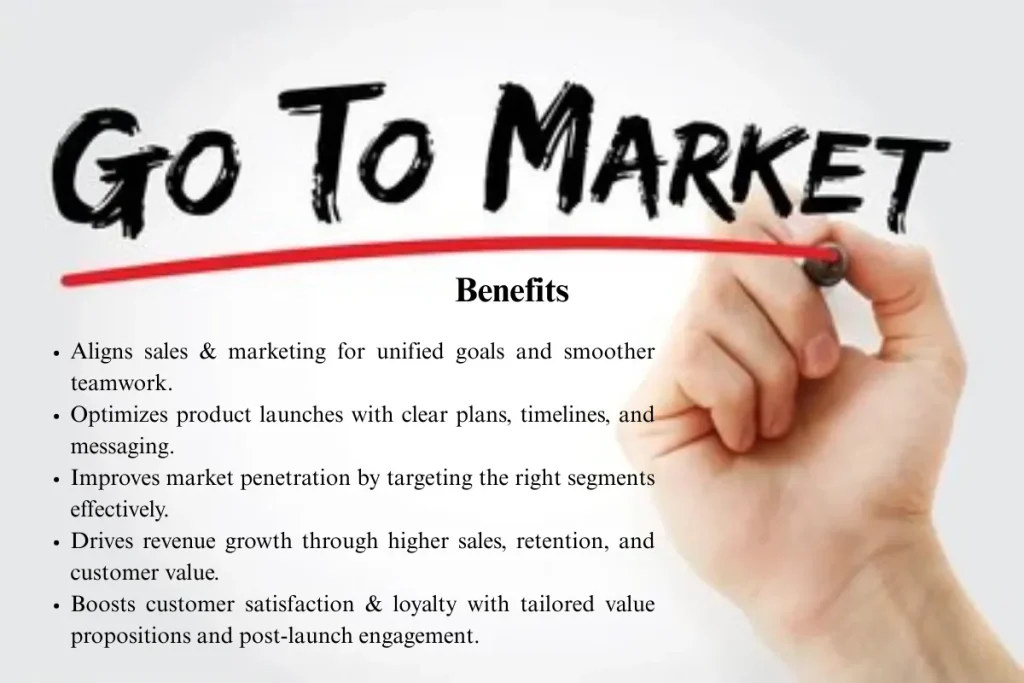
Aligning Sales and Marketing
A Go-to-Market (GTM) strategy is essential for aligning sales and marketing teams, ensuring that both departments work towards the same objectives. When sales and marketing are not on the same page, it can lead to confusion, miscommunication, and missed opportunities. A strong GTM strategy provides a clear framework for collaboration, ensuring that marketing efforts are fully aligned with sales goals and vice versa.
By creating a unified strategy, businesses can streamline their efforts, ensuring that both teams are targeting the right customers with the right messages. This alignment leads to a more efficient sales process, faster customer conversions, and a better customer experience overall. Sales teams can rely on marketing to generate qualified leads, while marketing teams benefit from knowing exactly what sales need in terms of messaging and customer insights. Ultimately, a strong GTM strategy leads to improved teamwork, increased productivity, and greater success in reaching business goals.
Optimizing Product Launches
One of the biggest advantages of having a well-structured GTM strategy is its ability to optimize product launches. A product launch is a pivotal moment for any company, and having a clear GTM plan in place ensures that all aspects of the launch – from marketing to sales to customer support – are coordinated effectively.
An optimized launch includes defining the right target audience, crafting compelling messaging, and selecting the appropriate sales channels to ensure maximum visibility. Additionally, a solid GTM strategy helps businesses to manage timelines, budgets, and resources more effectively, reducing the risk of delays and cost overruns. Whether you are launching a new product or entering a new market, an optimized GTM strategy provides the foundation for a successful launch that captures attention and drives customer adoption.
Furthermore, by tracking key metrics such as customer feedback, product adoption rates, and initial sales performance, businesses can quickly adjust their approach if needed, ensuring continued success even after the launch. A well-executed product launch leads to higher customer engagement, faster market penetration, and ultimately, stronger revenue growth.
Improving Market Penetration
Market penetration refers to how well a product or service has gained acceptance within its target market. A strong Go-to-Market strategy plays a crucial role in improving market penetration by ensuring that the product is positioned effectively and is reaching the right customers. By understanding market needs, leveraging effective sales strategies, and implementing targeted marketing campaigns, businesses can increase their products’ visibility and drive higher adoption rates.
A well-planned GTM strategy helps identify the most lucrative market segments and tailor the product offering to meet those customers’ needs. It ensures that the marketing efforts are directed at the most profitable and receptive audience, helping businesses cut through the competition and claim their market share. As businesses implement their GTM strategies, they continuously refine their approach to better serve their customers, leading to more successful and deeper market penetration.
Driving Revenue Growth
The ultimate goal of any Go-to-Market strategy is to drive revenue growth. A strong GTM strategy creates a roadmap for businesses to not only introduce their products to the market but also to sustain and grow their customer base over time. By focusing on customer acquisition, retention, and lifetime value, businesses can create a steady stream of revenue that builds over time.
A well-executed GTM strategy drives revenue by increasing sales, attracting high-value customers, and boosting product adoption. Through consistent marketing efforts, strategic sales outreach, and effective product positioning, businesses can establish a loyal customer base that generates recurring revenue. Additionally, by continuously optimizing their GTM strategy based on performance metrics, businesses can uncover new growth opportunities and fine-tune their approach to maximize profitability.
Improving Customer Satisfaction and Loyalty
A Go-to-Market strategy also has a direct impact on customer satisfaction and loyalty. By clearly defining the value proposition and aligning it with the needs and preferences of the target audience, businesses can ensure that customers receive a product that truly meets their expectations. A customer-focused GTM strategy creates an experience that resonates with the audience, leading to stronger brand loyalty and increased customer retention.
Furthermore, a strong GTM strategy includes post-launch efforts to engage with customers, gather feedback, and provide exceptional customer service. This helps businesses build lasting relationships with their customers, turning first-time buyers into repeat customers. Happy customers are more likely to refer others, creating a positive feedback loop that drives continued growth and enhances brand reputation.
The Future of Go-to-Market Strategies
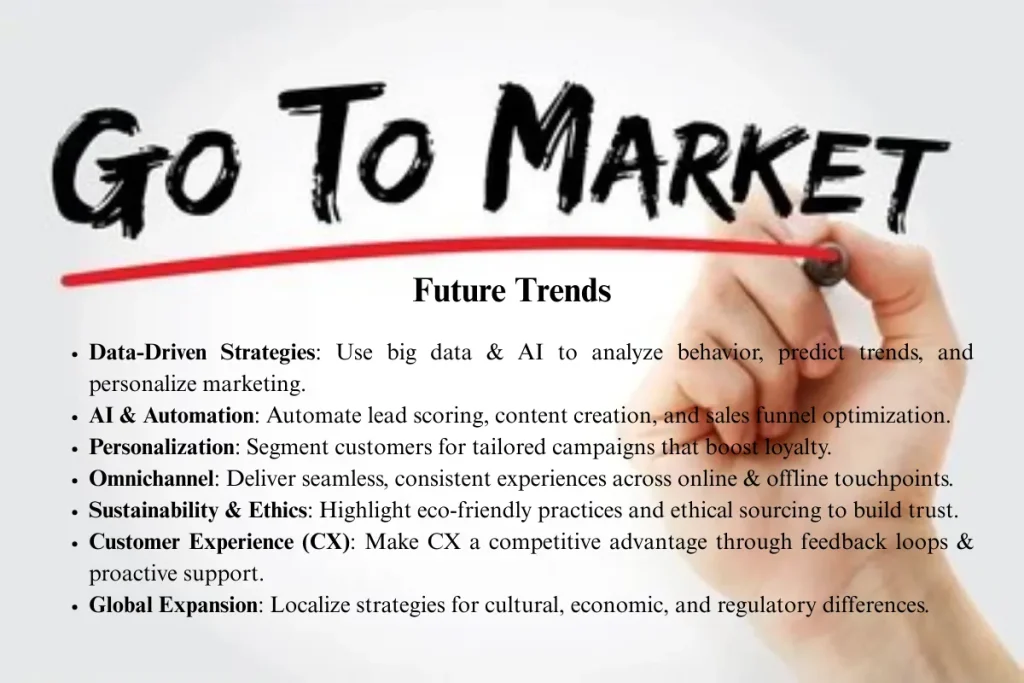
Evolving Trends in GTM
As industries continue to evolve, Go-to-Market (GTM) strategies are adapting to meet the changing demands of both businesses and consumers. Emerging technologies, shifting consumer behaviors, and the increasing importance of data are reshaping how companies approach their GTM plans. To stay competitive, businesses must remain agile and embrace the latest trends in GTM strategy development.
- Data-Driven GTM Strategies
- In the digital age, data has become one of the most important assets for businesses. Leveraging data analytics helps businesses understand customer behaviors, preferences, and market trends in real-time. By integrating advanced data analytics into their GTM strategy, companies can make informed decisions about product development, marketing campaigns, and sales tactics.
- Key Trend: Using big data and machine learning to analyze customer interactions, predict trends, and personalize marketing efforts. This data-driven approach allows for a more precise targeting of potential customers and ensures that marketing messages resonate with the right audience at the right time.
- In the digital age, data has become one of the most important assets for businesses. Leveraging data analytics helps businesses understand customer behaviors, preferences, and market trends in real-time. By integrating advanced data analytics into their GTM strategy, companies can make informed decisions about product development, marketing campaigns, and sales tactics.
- AI and Automation in GTM Strategies
- Artificial Intelligence (AI) and automation are increasingly being integrated into GTM strategies to streamline processes, reduce manual effort, and improve customer engagement. AI tools can help businesses analyze large datasets to identify patterns, create personalized marketing messages, and automate repetitive tasks such as email marketing and customer outreach.
- Key Trend: AI-powered tools are transforming GTM strategies by enhancing lead scoring, automating content generation, and optimizing sales funnels for better conversion rates. Automation also improves efficiency by reducing the time spent on manual tasks, allowing teams to focus on more strategic activities.
- Artificial Intelligence (AI) and automation are increasingly being integrated into GTM strategies to streamline processes, reduce manual effort, and improve customer engagement. AI tools can help businesses analyze large datasets to identify patterns, create personalized marketing messages, and automate repetitive tasks such as email marketing and customer outreach.
- Personalized and Customer-Centric Approaches
- Customers today expect highly personalized experiences across all touchpoints. Whether it’s a customized email, a tailored product recommendation, or a personalized ad, businesses need to understand their customers deeply to offer value. A customer-centric GTM strategy focuses on delivering personalized experiences that meet individual customer needs, which in turn drives customer loyalty and satisfaction.
- Key Trend: The use of customer segmentation and personalized marketing is becoming more prominent. By segmenting customers based on behaviors, preferences, and demographics, businesses can create highly targeted campaigns that resonate more effectively with their audience, increasing the likelihood of conversions and repeat business.
- Customers today expect highly personalized experiences across all touchpoints. Whether it’s a customized email, a tailored product recommendation, or a personalized ad, businesses need to understand their customers deeply to offer value. A customer-centric GTM strategy focuses on delivering personalized experiences that meet individual customer needs, which in turn drives customer loyalty and satisfaction.
- Omnichannel Marketing and Sales
- The shift towards an omnichannel approach is another significant trend in Go-to-Market strategies. Customers now engage with brands across multiple platforms, including social media, websites, physical stores, and mobile apps. An omnichannel strategy ensures that businesses provide a seamless and consistent experience for customers, no matter where they interact with the brand.
- Key Trend: Companies are increasingly integrating offline and online channels to create a unified experience. A GTM strategy that embraces omnichannel marketing ensures that marketing messages and sales efforts are consistent across all touchpoints, leading to stronger brand recognition and higher customer engagement.
- The shift towards an omnichannel approach is another significant trend in Go-to-Market strategies. Customers now engage with brands across multiple platforms, including social media, websites, physical stores, and mobile apps. An omnichannel strategy ensures that businesses provide a seamless and consistent experience for customers, no matter where they interact with the brand.
As businesses increasingly adopt data-driven strategies, leveraging technology for advanced analytics is key. GPU testing, for instance, plays an important role in evaluating the performance of AI models used in data-driven GTM strategies.
Adapting to Market Shifts and Consumer Expectations
Consumer preferences are constantly shifting, influenced by factors such as technological advancements, social changes, and global events. As such, businesses need to remain flexible and adjust their GTM strategies accordingly to meet evolving expectations. One major shift in recent years has been the increasing demand for sustainability and ethical business practices. Consumers are more conscious than ever about the products they purchase, and they seek brands that align with their values.
- Sustainability and Ethics
- A growing number of consumers prefer to engage with brands that are socially and environmentally responsible. As part of their GTM strategy, businesses must consider how to communicate their sustainability efforts and ethical practices. This could involve highlighting eco-friendly products, ethical sourcing, and corporate social responsibility (CSR) initiatives.
- Key Trend: Sustainability-focused marketing and ethical branding are becoming more important in GTM strategies. Companies that demonstrate a genuine commitment to social and environmental issues are likely to build stronger connections with their customers, leading to enhanced brand loyalty.
- A growing number of consumers prefer to engage with brands that are socially and environmentally responsible. As part of their GTM strategy, businesses must consider how to communicate their sustainability efforts and ethical practices. This could involve highlighting eco-friendly products, ethical sourcing, and corporate social responsibility (CSR) initiatives.
- Customer Experience as a Competitive Advantage
- As competition increases across industries, providing an exceptional customer experience has become a key differentiator. Businesses that can consistently deliver positive, memorable experiences across all customer touchpoints will gain a competitive edge. This includes not just the product or service itself, but also customer service, support, and post-purchase interactions.
- Key Trend: Customer experience (CX) is now a top priority for businesses looking to scale. Integrating feedback loops, offering proactive support, and leveraging technology to enhance CX are essential components of an effective GTM strategy.
- As competition increases across industries, providing an exceptional customer experience has become a key differentiator. Businesses that can consistently deliver positive, memorable experiences across all customer touchpoints will gain a competitive edge. This includes not just the product or service itself, but also customer service, support, and post-purchase interactions.
- Global Market Expansion
- With the rise of e-commerce and digital platforms, many businesses are looking to expand their reach beyond local markets and enter global markets. This requires adapting GTM strategies to different cultural, economic, and regulatory environments. A global GTM strategy needs to account for localization, currency differences, language barriers, and diverse customer preferences.
- Key Trend: As companies increasingly go global, there’s a growing focus on localizing GTM strategies to cater to different markets while maintaining a consistent brand message. Companies must also consider factors like local competition, market regulations, and logistical challenges when planning their expansion.
- With the rise of e-commerce and digital platforms, many businesses are looking to expand their reach beyond local markets and enter global markets. This requires adapting GTM strategies to different cultural, economic, and regulatory environments. A global GTM strategy needs to account for localization, currency differences, language barriers, and diverse customer preferences.
As companies scale their operations, partnering with a hyperscaler for cloud computing solutions can enable more efficient data management and faster time-to-market, a key component of modern GTM strategies.
The Future of GTM in a Digital-First World
The future of Go-to-Market (GTM) strategies will be shaped by digital transformation. As businesses continue to embrace new technologies and adjust to a digital-first world, GTM strategies will evolve to focus even more on automation, personalization, and data-driven decision-making. The integration of AI, machine learning, and omnichannel strategies will lead to more agile, efficient, and customer-centric approaches to market entry.
The future of GTM strategies lies in adopting a more holistic, data-driven, and customer-focused approach. Businesses that stay ahead of the curve by embracing emerging technologies and adapting to market shifts will be best positioned to succeed in an increasingly complex and competitive global marketplace.
Conclusion
A Go-to-Market (GTM) strategy is a critical framework for businesses aiming to successfully introduce a product or service to the market. It ensures alignment across sales, marketing, and product teams, helping businesses effectively reach their target audience and achieve faster growth. Without a clear GTM plan, companies risk missteps that could lead to wasted resources, missed opportunities, and failed product launches.
Understanding the GTM meaning and implementing a structured strategy is the key to a successful market entry. Whether you are launching a new product or expanding into a new market, a solid GTM strategy helps streamline efforts, optimize resources, and increase the chances of capturing market share and driving revenue growth.
FAQs
What does GTM stand for in tech?
In tech, GTM refers to the Go-to-Market strategy, which outlines how a company will sell and promote its technology products to customers.
What is GTM texting?
GTM texting refers to Google Tag Manager texting, a method used for managing marketing tags (like tracking pixels) on a website without modifying the code directly.
What does GTM mean as a job title?
As a job title, GTM often stands for Go-to-Market Manager, a professional responsible for overseeing the launch and market strategy of a product or service.





